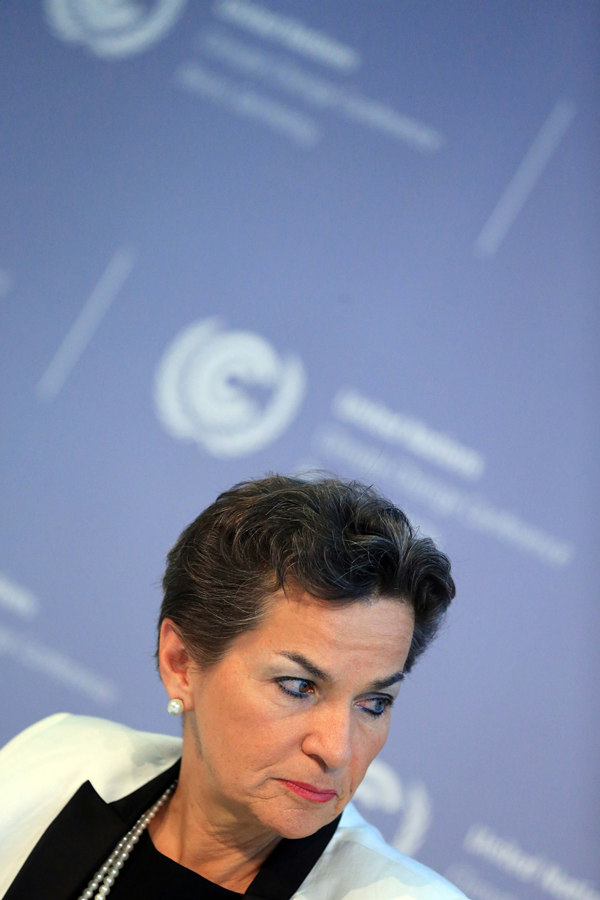China's climate efforts can be replicated internationally
Updated: 2015-10-19 05:58
By CHRIS DALBY and MAO PENGFEI(China Daily Latin America)
|
|||||||||
 |
|
Christiana Figueres, executive secretary of the United Nations Framework Convention on Climate Change (UNFCCC), attends a press conference during the latest round of United Nations negotiations on climate change in Bonn, Germany, on Sept 4, 2015. Provided to China Daily |
Ahead of the United Nations Conference on Climate Change (COP 21) to be held in Paris in December, China's efforts to fight climate change once again offered encouraging news to the world with its announcement that it would start the world’s largest nationwide cap-and-trade emissions control system, take new steps toward "green" financing and commit to further help developing countries.
The world has made huge progress in its fight against climate change in the past five or six years, according to Christiana Figueres, executive secretary of the UN Framework Convention on Climate Change Management.
During the World Bank Group (WBG)-International Monetary Fund (IMF) Annual Meetings held in Lima last week, Figueres praised the work that has been done but added that it was still not enough.
Ahead of the COP 21, 146 countries have presented climate change plans set to start in 2020. However, Figueres told China Daily that this timeline was still not enough to limit global warming to two degrees within the desired timeframe. Therefore, she has called upon countries to initiate their 2020 climate change plans early.
"We cannot wait until 2020," she said. "Policies must be fast forwarded and scaled up. We must see how quickly we can close the gap."
Admitting that "trillions of dollars would be needed", Figueres stated that a number of costs, including human, technological and infrastructure costs, needed to be factored in. While this might seem daunting to certain governments, she stated that "countries can see what others are doing, take the right measures, and adopt technologies to fight climate change."
"There is peer pressure among emerging countries. When China commits billions to help developing countries fight climate change, it helps change minds," said Figueres to China Daily.
During a visit in the United States in September, Chinese President Xi Jinping announced that China will set up a 20-billion-yuan ($3.1 billion) South-South cooperation fund to help other developing countries cope with the effects of climate change.
As an emerging economy, China's offer is a concrete pledge to fight global warming, said Peruvian Environment Minister Manuel Pulgar-Vidal, adding that the positive and generous step will benefit those developing countries that are short on funds.
The minister also pointed out that developed countries should shoulder their own historical responsibilities, reducing their own emissions while offering necessary financial assistance and technology transfers to developing countries.
Rachel Kyte, the World Bank's special envoy for climate change, said that it was necessary to help every economy move toward a low-carbon direction and support them with funds, especially those least developed countries. China's generous offer was absolutely a new move, and received very positive feedback, she said.
During the annual meetings in Lima, senior executives of the IMF launched a broadside against fossil fuel subsidies around the world, calling them the “most wasteful use of public spending” and urging all governments to end them.
According to Zhu Min, IMF’s deputy managing director, the EU and a few other countries already have carbon pricing in place, but at around $10 per ton of CO2. While he called this a good start, he said that in the medium-term, it should go up to $50 to $60 per ton.
Zhu also duly noted that implementing a carbon tax is not difficult as it is an extension of existing fuel taxes, but that countries needed to make a firm political and popular commitment to push it forward.
In China, that commitment should not be hard to find. With pollution affecting many cities, there is broad public support in China for immediate action to cut emissions. Furthermore, China’s reduction of carbon emissions in 2015 is very likely to set a global record. It has made progress in other areas such as seeing its coal consumption peak and begin to decline.
This does not mean China can rest on its laurels, Zhu advised. With oil prices halved, there is no better time for China to continue with its own path of emission reductions.
President Xi Jinping announced China’s emissions trading system during his state visit to the US in September. As part of a joint presidential statement on climate change with President Barack Obama, Xi stated that China “plans to start in 2017 its national emission trading system, covering key industry sectors such as iron and steel, power generation, chemicals, building materials, paper-making and nonferrous metals.”
The scheme commits China to promoting low-carbon buildings and transportation, with the share of newly built green buildings reaching 50 percent and the share of public transport reaching 30 percent in big- and medium-sized cities by 2020.
To direct its society and industry toward a green model of development, China is taking three key steps to reform its financial sector towards green and sustainable finance, said Yi Gang, deputy governor of the People's Bank of China (PBOC) in Lima.
The first step is to bring private and public money together in sustainable finance. China will need to invest 2.4 trillion RMB ($377.8 billion) a year in the green sector, according to Yi.
"However, government resources can only cover 15 percent of this. The rest must come from the private sector," said Yi, adding China will combine its monetary policy, fiscal policy, tax system and pollution control measures to design a positive incentive mechanism to get investment.
The second step is to design a green financial market, Yi said, adding that despite China's vast financial sector, its financial structure heavily depends on banks while the insurance and fund segments lag behind.
Therefore, the main goal for China's green financial market will be to ensure that more and more bank lending becomes green, Yi said.
"We will also work on green bonds, green investment funds, green insurance and carbon trading mechanisms. A green financial market will facilitate (the creation) of green financial instruments to continue sustainable finance in a commercially viable way and maintain private investment," he said.
Thirdly, Yi said, China was calling for international cooperation to tackle common problems such as pollution and other environmental problems.
"Environmental problems and pollution have large externalities. If any one country commits to green finance, it benefits the whole world. These heavy externalities mean that, without global cooperation, the green sector will be under-invested and polluting industries will be over-invested," he said.
Despite China’s successes, the aim to have each country cut emissions and set carbon pricing, according to its own capacity, is all good but the determination of that capacity cannot be made solely at the national government level.
According to Martin Parkinson, Australia’s former Treasury Secretary, if all 146 countries that have tabled climate change plans meet their obligations, the global temperature will rise by 2.7 degrees. Good, but nowhere near good enough, he said.
The COP 21 meeting in Paris to be held in December is perhaps the last chance to bring some much-needed consistency to local and global climate change combatants. The likes of China and the US, as exemplified by their November 2014 commitment to significantly curb emissions, will have to show that national victories must now be rolled out and replicated at the international level.
- EU offers Turkey cash, closer ties for migration help
- ROK, Japan to hold defense ministers' talks next week
- 5 countries elected as non-permanent members of UN Security Council
- Obama slows pace of US troop withdrawal in Afghanistan
- Democratic rivals back Clinton on emails
- Myanmar gov't signs ceasefire accord with armed groups

 Trump card
Trump card
 Shaolin monks display kung fu skills in London
Shaolin monks display kung fu skills in London
 'Newlyweds' are 'floating' on air in Zhengzhou
'Newlyweds' are 'floating' on air in Zhengzhou
 Buckingham Palace prepares for Xi's visit
Buckingham Palace prepares for Xi's visit
 Shanghai Fashion Week: We COUTURE
Shanghai Fashion Week: We COUTURE
 World's top 10 innovative economies
World's top 10 innovative economies
 Cui: China, US should share global vision
Cui: China, US should share global vision
 Speaking Mandarin attracts Chinese homebuyers in the US
Speaking Mandarin attracts Chinese homebuyers in the US
Most Viewed
Editor's Picks

|

|

|

|

|

|
Today's Top News
Tu first Chinese to win Nobel Prize in Medicine
Huntsman says Sino-US relationship needs common goals
Xi pledges $2 billion to help developing countries
Young people from US look forward to Xi's state visit: Survey
US to accept more refugees than planned
Li calls on State-owned firms to tap more global markets
Apple's iOS App Store suffers first major attack
Japan enacts new security laws to overturn postwar pacifism
US Weekly

|

|








